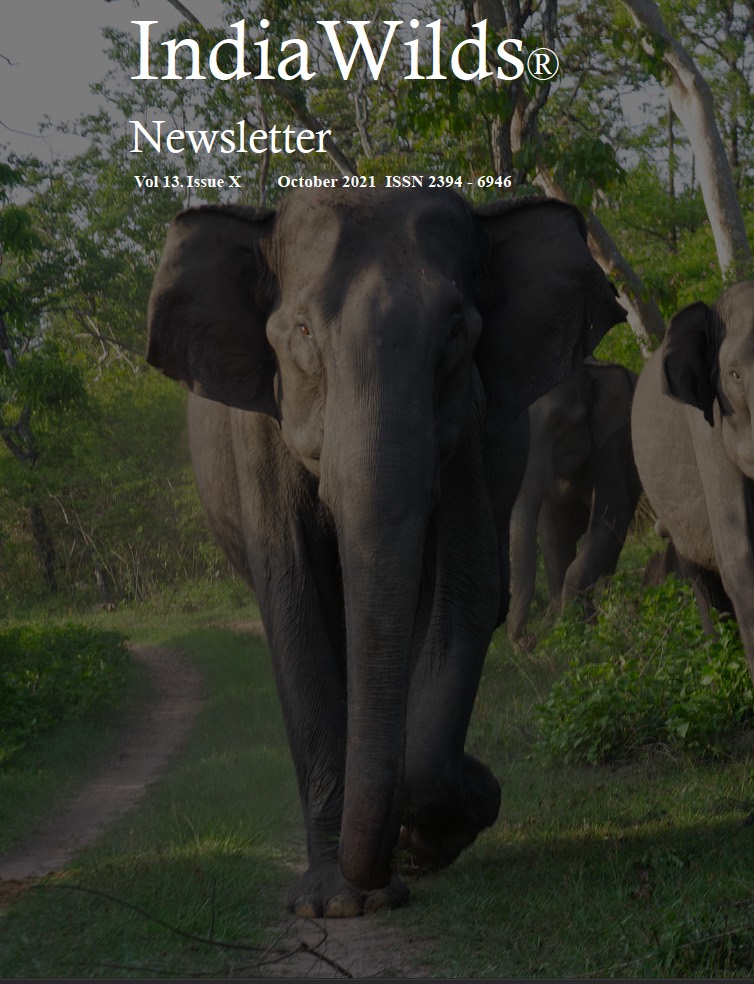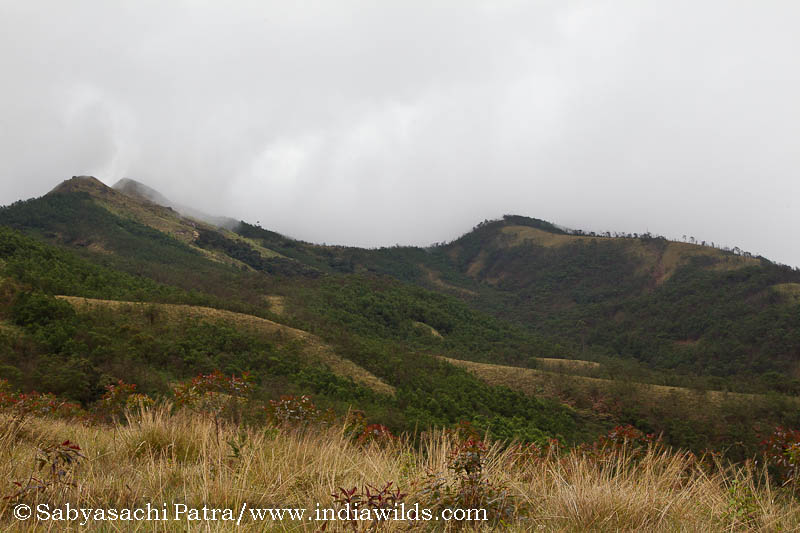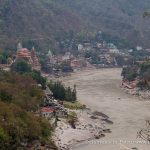IndiaWilds Newsletter Vol. 13 Issue X
ISSN 2394 – 6946
Forest Conservation Act: Soon to lose all its teeth
In the past few years, in the name of ease of doing business, there have been multiple attempts to amend our acts which stand in the way of vested interests decimating our forests and wildlife. Recently MoEF has proposed a set of amendments to the Forest (Conservation) Act, 1980 which will sound a death knell on our wilderness areas and wildlife.
Forests to give way to plantations:
The present ruling dispensation had earlier tried to obfuscate the definition of forests and had included plantations in the assessment of total areas in India covered under forests. As a result, it was being shown that the total area under forests and tree cover is growing even though large swathes of forest land was being diverted for industries, dams, roads, mines and other projects. So it is indeed funny to see some proposal regarding changing definitions of forest.
A simple tree plantation will not create a forest. Plantations don’t have the complex ecological linkages that natural forests have. Of course, when plantations are left wild and unmanaged for years and remain inviolate ie. devoid of human presence, then over many years the species diversity can increase primarily due to natural seed dispersal by birds. Plantations that are adjacent to forests have a role to play in dispersal of wildlife as they can often use these areas.
In the Godaverman vs Union of India case, the Hon’ble Supreme Court had said that any land which has trees would be considered as a forest and the land for all practical purposes will be considered as a forest land. So the law for forest protection and diversion of lands for non-forest use were applicable.
The proposed amendments to the Forest Conservation Act says that there is considerable apprehension is raised about prosecution of people for cutting forests. However, a cursory look at any newspaper will show that despite thousands of people protesting cutting down of large hard growth trees in cities, tree cutting goes on unabated. No one is persecuted. People also start pruning and chopping off the portions of the tree trunk so that trees die and then they easily cut off. Clearly the issues raised about apprehensions of private people about seeking permission to cut down trees in their land to cause wholesale changes in the forest conservation act is unwarranted.
If the Government succeeds in changing the definition of forests and excludes private property with forest cover from it then it will ensure that the lands which saw compensatory afforestation will no longer be protected.
Also, Government can then use it as a loophole and then divert forests and then create plantations like palm oil or other such produce for purely commercial reasons. We all know how Malaysia’s bio-diversity has been devastated by its push for converting pristine forests into palm oil plantations. India too is following in the same path.
The authors of the proposed amendments to the FC Act perhaps are not aware climatic conditions in India and the nature of our land. Else they would not have written “It is also a fact that India being largely a tropical country, there is a natural tendency of a land to grow spontaneous wild growth of vegetation, which if left on its own will develop a forest like vegetation over a period of time, bringing such unattended lands under the category of deemed forest as per dictionary meaning. Such lands would continue to attract provisions of the Act. Therefore, people in general have a tendency to prevent any tree like vegetation growing on their land.”
For the record, 69% of India’s geographical area amounting to 228.3 Million hectares is under dry land (arid, semi-arid and dry sub-humid) and 32% of India’s total land is affected by land degradation. Out of this 81.45 Million Hectares or 24.8% of India’s total geographical area is affected by desertification. https://www.indiawilds.com/diary/indiawilds-newsletter-vol-9-issue-vi/
Injecting Cancer :
The point B. 5 says “Alongside many roads and railway lines, strip plantations have been developed and notified as forests. In many areas road/rail side amenities/habitations have been developed all along such lands. These facilities (both private and government) need access (approach roads/rail) and that invariably pass through the strip of notified forest area along the road/rail line. Since the activity is a non-forestry use of forest land, these require prior approval of Central Government. The requirement of forest land in each case is around 0.05ha. Ministry is of the view that, an exemption up to 0.05ha for each such accesses may be allowed to alleviate the hardship of the residents/business owners.”
The above proposed amendment to allow clearing up 0.05 hectares of land for non-forestry use is meant to insert a loophole to destroy our forests. This loophole will ensure that simultaneously 0.05 hectares of land in different areas would be cleared up to pock mark the forest. Then later some more would be cleared up adjacent to the already cleared up land. This will ensure wholesale clearing up of forest land. This proposal is like inserting cancerous cells in the body of our forests as well as Forest (Conservation) Act. With time, these small 0.05 hectares will fuse together to ensure that our forests will become decimated and Mother India will get a bald look.
The proposed amendments don’t take into consideration that fragmentation of our forests is the biggest bane of genetic diversity and survival of our species. Forest fragmentation due to creation of linear projects like roads, railways, dams, industries etc result in many species not able to move in their habitat and causes problems in genetic diversity. There are many wildlife mortalities when animals as well as herpeto-fauna try to cross a road. Loss of forest cover also impacts existing wildlife corridors and hence natural dispersal of wildlife to other forests is stopped. When wildlife on their own try to move from one forest to another they come in contact with human beings and there is conflict resulting in loss of life. Wish the authors of the proposed amendments to the forest act had the well-being of wildlife and ecologically fragile forests in mind.
Need for Perpetual No Go areas:
The proposal to include a “enabling provision in the Act to keep certain pristine forests showcasing rich ecological values intact for a specific period” is a double-edged sword given the track record of the Government in decimating our forests. In the better part of the last decade, the NBWL (National Board for wildlife) has been acting as a clearing house of forest diversion proposals. Filled with yes men and women, there is rarely a proposal which gets rejected. In many cases, NBWL Members don’t even get the proposals before hand to study. Given this background, it is feared that inserting protection of a forest for a specific period, even though with a pristine classification, there are chances of review and divestment after the specific period is over. India is famous for its “jugaad” or ingenuity and we can find loopholes and intentionally misinterpret clauses. So, it would be important to create a clear “Perpetual NO GO” area for forests in ecological fragile areas and those which has rich ecological values.
Defence use:
These days no project, howsoever detrimental to wildlife and ecology of the area may be, if a project is said to be beneficial for defense needs, then the projects are immediately cleared. Too often, defense personnel are not aware of the ecological value of a place and dependencies of wildlife on the area. Defense decide on setting up base or creating defense infrastructure in an area or completely take over an area based on whatever they think is right. Only when such a project proposal comes up to the ministry for clearance the conservation community gets a chance to raise their voice. So, the decision of the ministry to give blanket approval for projects that are deemed to be of strategic and security interest will lead to decimation of our wilderness areas and wildlife. It can also lead to extinction of species like in the case of development of a base impacting the Narcondam Hornbill– a bird which is endemic to Narcondam island in the Andamans.
Fait accompli:
A number of ecologically fragile areas have been destroyed by the argument of fait accompli. Many private players as well as Government agencies have used the Fait Accompli route to argue that they have already spent lot of money in the project and hence they should be given forest clearance. Most of the dams in Uttarakhand and elsewhere, road projects, mining projects, Sethusamudram project to name a few have used this argument that already hundreds of crores of money has been sunk in the project and hence to avoid losses they should get the permission to divert forest land. The Forest (Conservation) Act 1980 should be amended to clearly say that in no case fait accompli argument would be valid ground for seeking forest permission. Often Government officials with or without the pressure of political masters and in collusion with private sector allow work to start in non forest areas adjacent to forest and then seek permission. In many cases, work has started even in forest areas without the necessary forest clearance. This needs to be plugged. However, given that the present Government is keen in opening up our forests for exploitation, conservationists are not very hopeful.
Extended Reach Drilling: A retrograde move
The proposed amendment reads “New technologies are coming up such as Extended Reach Drilling (ERD), which enables exploration or extraction of oil & natural gas deep beneath the forest land but making drilling holes from outside the forest areas and without impacting the soil or aquifer that supports the forest in the forest land. Ministry considers use of such technology is quite environment-friendly and as such should be kept outside the purview of Act.”
Allowing ERD (Extended reach drilling) in forest areas is going to be a disastrous for our ecologically fragile areas. No studies have been conducted to understand the impact on our wildlife and wilderness areas. It is known that lot of animal communication is in sound frequencies that are beyond our human hearing range of 20 Hz to 20Kz. Elephants, tigers etc. communicate through infrasound which are lower than our hearing range of 20Hz. Similarly bats and many species can hear ultrasound. Animals, birds, herpetofauna are very sensitive to vibrations. With loud noise there is higher palpitations. Often it leads to miscarriage in animals. Animals often desert those areas. Allowing Extended reach drilling will cause problems for wildlife. Extended reach drilling is also likely to cause diversion of underground natural water flow channels and can be detrimental to the ecologically fragile forest lands. Hence, it should not be allowed.
Reclassifying Non-forestry activities as Forestry
The clause 2.11 in the proposed amendment will be seriously detrimental to the health of our forests and wildlife. It proposes “The clause of explanation to ‘non-forestry use’ in Section 2 of the Act, identifies activities which are to be regarded as non-forestry activity and which are not for the purpose of that Section. It is understood that activities which are ancillary to conservation of forests and wildlife should not be considered as non-forestry activities. Accordingly, it has been proposed that, establishment of zoos, safaris, Forest Training infrastructures etc should not come within the meaning of “non-forestry activity” for the purpose of Section 2(ii) of the Act.”
The above proposed amendment wants to change the definition of non-forestry activities and want to make zoos, safaris, forest training buildings etc. as forestry activities. If allowed, this would be a big blow to forest and wildlife conservation. Erecting any kind of concrete structure inside forests and ecologically fragile areas should be frowned upon. Based on our experience, we have seen first forest department creates a concrete house and then slowly the place becomes very big. In many of our premier national parks like Corbett, Parambikulam etc what was once a place where we used to sight huge congregation of animals, today we find forest buildings. In Similipal, I saw the sad sight of forest ranger and staff chasing away elephants that were grazing inside the forest range office compound wall.
Most of these buildings are done at ecologically fragile areas and come as a big blow to our wildlife. Also, one needs to question why do you need huge buildings in this digital era when people have smartphones and laptops? Take the people on a trek and teach.
These days, forest authorities are more concerned about increasing their revenue. So, they want to create zoos and fenced safari drives so that tourists can move in the fenced enclosures in vehicles to see animals and feel they are viewing wild animals. These fenced enclosures give an illusion that all is well with our wildlife as people don’t realise that they are visiting a zoo adjacent to a national park. Perfectly healthy animals are captured and kept in zoos so that they can get more revenue from tourists. It is surprising, that a nation which suffered immensely under British rule and has been celebrating its freedom since 1947, is unable to appreciate what freedom means to other species. Why do we need to keep wildlife under captivity just for our pleasure? As such zoos have outlived their utility as they no longer primarily aid in species reintroduction in the wild. Also, people learn more from wildlife films than watching a bored and stressed tiger inside a tiny cage.
If we allow establishment of zoos, safaris, forest training infrastructure etc. to be reclassified as forestry activity, then there will be proliferation of such activities and our forests will be decimated.
Our wildlife need inviolate spaces to breed and thrive. Unfortunately, it is proposed that Survey, reconnaissance, prospecting, exploration or investigation inside reserved forest land will not be categorized as non-forestry activity. Clearly this is done at the behest of large corporations who want to explore for oil, minerals, gems and other such activities for their own gains. These activities once removed from the non-forestry list will be allowed unhindered and hence will cause even more disturbance to our wildlife. This would be an anti-wildlife move and is highly condemnable.
Penal Provisions:
he proposed amendment says that “offences under Section 2 is now proposed to be made punishable with simple imprisonment for a period which may extend to one year and the offence shall be cognizable and non-bailable. It has also been proposed to introduce the provisions for penal compensation in addition to the punishment under section 3A to make good for the damages already made.”
We are of the view that imprisonment of three years would be a serious deterrent along with a minimum financial penalty of Rs. 10 lakh. These days selling one big teak tree results in lakhs of rupees. So, the financial penalty has to be increased along with a minimum period of imprisonment of three years. This will make the people think twice.
The FC Act should also be amended to include that if any Government servant allows permission for work to start in projects without first obtaining forest permission then those persons would be prosecuted. Too often we find bureaucrats process the files knowing that they would retire soon and hence chances of giving explanations for circumventing the rules may not arise. Given the general inclination of authorities, we don’t expect this to ever be included in the rules. Nevertheless, everyone in a democracy should be accountable.
The MoEF has given less than a month to provide the feedback on the proposed amendments. There is also a confusion about the email id where the feedback should be sent. It is not sure if all the submissions are going to be considered. If the Government goes ahead with the proposed changes in the Forest (Conservation) Act, then it would be disastrous for the health of our forests and wildlife. Our forests and wild lands are our natural heritage. India’s culture and religion is inextricably linked with its forests. We need to retain our forests in pink of health for posterity. Any action to damage the health of our forests is anti-national. It would be the biggest act of sacrilege that one can commit. So, we urge the Government to change its mind and drop these proposed changes to our Forest (Conservation) Act else our forests will be decimated.
Conservation News:
Paddy straw generated in Punjab, Haryana and U.P. expected to come down significantly this year
Steps taken towards reduction in paddy straw generation is yielding positive results. The total paddy area in the states of Haryana, Punjab and eight NCR Districts of Uttar Pradesh (U.P.) have come down by 7.72 per cent during the current year as compared to last year. Similarly, total paddy straw generation from the non-basmati variety is likely to be reduced by 12.42 per cent during the current year as compared to the previous year.
Both Central and State Governments of Haryana, Punjab and U.P. have been taking measures to diversify crops as well as to reduce the use of PUSA-44 variety of paddy. Burning of paddy straw from the non-basmati variety of crops is the prime concern. Crop diversification and moving away from PUSA-44 variety with short duration High Yielding Varieties are part of the framework and action plan for control of stubble burning.
As per data received from the State Governments of Haryana, Punjab and U.P., the total amount of paddy straw generated will come down this year. The total paddy straw generation is likely to come down by 1.31 million tonnes (from 20.05 million tonnes in 2020 to 18.74 million tonnes in 2021) in Punjab; by 0.8 million tonnes (from 7.6 million tonnes in 2020 to 6.8 million tonnes in 2021) in Haryana and; by 0.09 million tonnes (from 0.75 million tonnes in 2020 to 0.67 million tonnes in 2021) in the eight NCR districts of U.P. this year.
The total quantity of straw generated by the respective states was 28.4 million tonnes in 2020 which is now expected to come down to 26.21 million tonnes in 2021.
The decrease in non-basmati variety is expected to be even higher. Paddy straw generation specifically from the non-basmati variety of crops is expected to decrease from 17.82 million tonnes in 2020 to 16.07 million tonnes in 2021 in Punjab and from 3.5 million tonnes in 2020 to 2.9 million tonnes in 2021 in Haryana.
The Commission through a comprehensive framework had directed the respective State Governments to promote short duration and early maturing varieties of crops since they can be managed quite efficiently and provide a much wider window for paddy straw management. As per recommendations of the Ministry of Agriculture and Farmers Welfare, Government of India, CAQM had actively pursued with State Governments for promotion of the same.
Apart from this, the Crop Diversification Programs are also being implemented in the states of Punjab and Haryana along with the NCR Districts of U.P. to divert the area of water-guzzling paddy to alternate crops.
World needs rapid and transformative actions
18th October 2021
Participating virtually in the Like Minded Developing Countries (LMDC) Ministerial meeting titled “‘Preparations for COP 26 on Climate Change – Expectations and Challenges’ today, Union Minister for Environment Forest and Climate Change, Shri Bhupender Yadav today called for rapid reduction of emissions by developed countries in this decade.
Shri Yadav in his address noted that world needs rapid and transformative actions, in view of the fact that the remaining global carbon budget is meager and will be exhausted within this decade at the current rate of global emissions. He also noted that the commitments of carbon neutrality and to raise ambitions in nationally determined contributions to be in line with climate justice and principles of equity and common but differentiated responsibilities and respective capabilities (CBDR-RC).
The Environment Minister highlighted the ambitious climate actions taken up by India in areas of renewable energy, energy access, and efficiency, sustainable transport including e-mobility, sustainable agriculture, enhancing green cover, etc. He noted that India has achieved a reduction of 24% in emission intensity of its GDP between 2005 and 2016, thereby achieving its pre-2020 voluntary target.
Minister pointed that the accelerated climate action by developing countries like India requires the contingent provision of climate finance, technology, and other means of implementation support. He also highlighted the importance of global partnerships and cooperation and requested the LMDC countries to join the initiatives of International Solar Alliance (ISA) and Coalition for Disaster Resilient Infrastructure (CDRI) launched by India.
The ministerial level Like-Minded Developing Countries group meeting has been hosted by Plurinational State of Bolivia ahead of upcoming crucial upcoming 26th climate change conference to be held in Glasgow, UK from October 31 to November 12, 2021. LMDC comprises of around 25 developing countries from Asia and other regions.
A ministerial statement was endorsed by the LMDC Ministers during the meeting, expressing their full support to COP26 Presidency and willingness to work closely and constructively with all other Parties and stakeholders towards a successful COP26 through the multilateral process that is conducted in an open and transparent, inclusive, Party-driven and consensus-based manner.
At COP 26, all important pending issues should be resolved mutually taking into account national priorities and circumstances
21st October 2021
Stressing on the urgency of strong climate actions the Union Environment Minister, Shri Bhupender Yadav underlined the need for initiating the process of setting the long-term climate finance for post-2020 and the fulfilment of the goal of USD 100 billion committed by developed countries at the bilateral held in New Delhi with H.E. Mr. Frans Timmermans, Executive Vice President- European Green Deal, European Union.
Both sides discussed a wide range of climate issues relating to COP26, EU and Indian climate policies, bilateral cooperation between the EU and India.
On the upcoming COP-26 the Environment Minister stated that in the COP 26, all important pending issues like Article 6, Common Time Frame, Enhanced Transparency Framework, etc. should be resolved mutually taking into account national priorities and circumstances.
Both sides acknowledged that India and the EU should work together to achieve a successful outcome of COP26 to enable full and effective implementation of the UNFCCC and the Paris Agreement.
Shri Yadav also highlighted India’s ambitious climate action plans under the visionary leadership of Prime Minister Shri Narendra Modi towards a green transition covering the priority areas of renewable energy, sustainable transport including e-vehicles, energy efficiency, forest, and biodiversity conservation, etc.
Applauding, India’s leadership on Climate Actions, Mr. Timmermans said that the whole World is in admiration of India’s ambitious target of 450 GW of renewable energy by 2030.
Both sides may explore to further strengthen the bilateral cooperation on climate and environment, especially on ways and means which help in promoting low carbon pathways.
COP26 should be the COP of action and implementation
22nd October 2021
Union Minister for Environment, Forest and Climate Change, Shri Bhupender Yadav today assured India’s full support to the UK COP Presidency for the meaningful outcome of COP, and said that the upcoming COP26 should be the COP of action and implementation.
Shri Bhupender Yadav, had a bilateral meeting with Right Honourable Ms. Elizabeth Truss, UK Foreign Minister, toady in New Delhi. In the meeting, they discussed crucial issues COP26, UK COP26 initiatives, India UK Roadmap-bilateral cooperation, Commonwealth Declaration on Climate Change, and other related issues.
In the Meeting, Shri Yadav said that the huge expectations in COP 26 include arriving at a consensus on unresolved issues of the Paris Agreement Rule Book, long-term climate finance, market-based mechanisms, etc.
Stressing that COP26 should also initiate the process of setting the long-term climate finance for the post-2025 period, Shri Yadav stated that India welcomes the UK COP 26 Presidency’s five key initiatives on sustainable land use, energy transition, low emission vehicle transition, climate finance, and adaptation.
In the Meeting, both sides underlined the need for strengthening bilateral partnership and collaboration to facilitate the collective R&D of cutting-edge technologies and the transfer of proven technologies to drive low carbon pathways.
Both sides also agreed to explore ways and means to also strengthen global climate initiatives including the International Solar Alliance, Coalition Disaster Resilient Infrastructure (CDRI), leadership Group for Industry Transition (LeadIT Group), Call for Action on Adaptation and Resilience, and Mission Innovation.
Project to control air pollution from dispersed sources in Delhi
Considering the large number of non-point dispersed sources contributing to air pollution in Delhi, a Project to control air pollution from dispersed sources will be implemented in Delhi with special focus during the coming winter season.
The Commission for Air Quality Management in National Capital Region and Adjoining Areas (CAQM) with the support of an NGO, Air Pollution Action Group (A-PAG), had initiated a Pilot Project with the active help of South Delhi Municipal Corporation (SDMC) in its jurisdiction in the month of December, 2020 to abate air pollution from large number of non-point dispersed sources.
The progress of the Pilot Project by SDMC was reviewed by CAQM on 22nd September, 2021 and based on the learning and outcome of the project, NDMC, North DMC and East DMC have expressed their interest in replicating the project in their respective jurisdictions.
Based on the learning from the Pilot, the Project is now being upscaled and replicated in North DMC, East DMC and New Delhi Municipal Council (NDMC) areas to control dispersed sources air pollution in the coming winter season. The Project envisages easy identification, allocation and resolution of air pollution-related issues arising out of large number of non-point dispersed sources.
At the Review Meeting held by the Commission on 21st October, 2021 with Delhi Government Officials and Commissioners / Chairpersons of Municipal Corporations /New Delhi Municipal Council, it has been decided that the project will go live in North DMC, East DMC and NDMC w.e.f. 27th October, 2021 with improved inter-agency coordination among Delhi Pollution Control Committee (DPCC), Nodal Officers and support from other agencies concerned. Standard Operating Procedure (SOP) has also been formulated for this purpose.
SUCCESS OF PILOT
Supported by a robust review & monitoring program, the Pilot Project was successful in identifying about 17,290 issues in 104 wards of South DMC, out of which 10,900 (63%) of the issues pertain to the SDMC and the rest 6,400 (37%) issues have been assigned to other agencies. Under this pilot project, SDMC has successfully resolved 95% of the issues pertaining to its own jurisdiction. The project inter-alia focused mainly on the following steps:
- Sensitization Exercise to help ground-level officials understand the linkages between their daily tasks and the quality of air
- 3rdParty Survey to identify issues that contribute to spike in air pollution levels
- Allocation of issues identified and further tag them to the agencies concerned
- Ground-level reporting of resolution of the issues by the authorities concerned
- Enhancement of SmartCity 311 App to improve efficiency and effectiveness of the complaint redressal processand
- Review Process to follow through on-ground survey procedure and ensure high standards while resolving the issues.
The major pollution sources addressed under this pilot project are: garbage dump sites, overflowing dhalaos, burning of garbage, construction & demolition sites, debris dumped on public land, road dust from unpaved roads, barren lands, industrial emissions, vehicular pollution etc.
Viewing the need for technological advancement as the most crucial step towards transforming the whole complaint redressal process, SDMC with technological support of A-PAG brought enhancements to the SDMC’s 311 Live Dashboard and upgraded it into an advanced ‘SmartCity 311 App’ for efficient and effective monitoring of dispersed sources of air pollution.
With the introduction of this advanced App, issues can be conveniently raised with a single tap. The ‘SmartCity 311 App’ carry a number of enhanced features like a simplified transfer protocol to reassign issues to other agencies, validation check to mark resolution has been introduced, updated reporting formats for easier monitoring, feature to track progress on long term issues and features to ensure officials are present at the issue site while uploading the resolution proof.
Citizen participation is an important aspect of collection of information from different sources in real-time. This not only strengthens the process of citizen-led issue identification but also expands the reachability of the system. Apart from on-ground 3rd party surveys, the SmartCity 311 App will also allow and encourage the citizens to raise complaints and help the municipal bodies in taking necessary steps to redress the issues concerned.
Besides sensitization workshops for increased understanding of air pollution issues arising out of dispersed sources, special focus has been laid by the SDMC on long term issues affecting the air quality during the Pilot Project. The progress of the Pilot Project by SDMC was reviewed by CAQM on 22ndSeptember, 2021 and based on the learning and outcome of the project, NDMC, North DMC and East DMC have expressed their interest in replicating the project in their respective jurisdictions.
As per reports received by the Commission, the Air Pollution module is now live on the citizen app in SDMC & EDMC.
Equipment Discussions:
DJI launches Ronin 4D – integrated gimbal camera
Sony launches 33 Megapixel Alpha 7 IV mirrorless full frame camera
Sony launches 33 Megapixel Alpha 7 IV mirrorless full frame camera
Natural History
COUNTRY NOTEBOOK: M. Krishnan: ‘Spring in the Jungle‘ shared By Saktipada Panigrahi
https://www.indiawilds.com/forums/showthread.php?8852-Country-notebook-m-krishnan&p=58194#post58194
TEDx Talk: Learning from India’s Wilds
A recent TEDx talk by Sabyasachi Patra explores the strategies wildlife use in their life and death battles. These learnings can help we humans in improving our lives.
Photography Tips – Learning Exposure
To make photography learning easier, we are creating a photography tutorial video series. The first part of photography tips is on learning exposure. Check it out in this link: https://youtu.be/PT3vvNIJx1g
Wildlife Photography
Leopard on Rock by Sabyasachi Patra
https://www.indiawilds.com/forums/showthread.php?20037-Leopard-on-the-rock
Leopard Snarling by Shyamala Kumar
https://www.indiawilds.com/forums/showthread.php?20029-The-Snarling-one
Gaurs by V S Sankar
https://www.indiawilds.com/forums/showthread.php?20017-Always-Alert!-Gaurs
Changeable Hawk-Eagle by Mrudul Godbole
https://www.indiawilds.com/forums/showthread.php?20014-Changeable-Hawk-Eagle
Lizard by Arun Acharjee
https://www.indiawilds.com/forums/showthread.php?20019-Lizard-a-close-up
Common nawab butterfly caterpillar by Prajwal Ullal
https://www.indiawilds.com/forums/showthread.php?20013-The-dragon-of-the-butterfly-world
Spare a Thought
This is the 154th issue of IndiaWilds. An image of an angry charging wild elephant adorns the cover page of this issue.
Unlike the African elephants, in India female elephants don’t have tusks. Some male elephants too don’t have tusks and are knowns as makhna. The forehead part of makhnas or tuskless male asiatic elephants is more well developed than the other elephants. With more and more elephants being illegally hunted down, researchers find that Makhnas or tuskless elephants have more chance of survival in the wild. It would be a tragedy if in a few decades we lose all our majestic tuskers and only makhnas and female elephants survive in the wild.
Culturally our elephants are seen as a symbol of prosperity and peace and associated with divinity. The King of Gods, Lord Indra has Aairavat elephant as his vehicle. Goddesses of wealth Laxmi has elephant as her vehicle. The God of learning and destroyer of all impediments Ganesha has an elephant head. Despite all this today our wild elephants are a persecuted lot.
Elephants with their huge bulk and less efficient digestion process require them to feed major parts of the day and night. So, elephants need vast space to roam around in search of food. Their age-old migratory pattern was based on availability of different types of plants, fruits according to season. Unfortunately, today most of their traditional migratory corridors have been appropriated by people and the landscape modified for our own use. So elephants no longer have access to these lands as well as those seasonal fruits, flowers, shrubs, creepers, and other vegetation is no longer available. Elephants have also realised that they get more calories from cultivated food grains. So, they easily take to grazing in the agriculture fields.
On top of this, the species diversity inside the forest has also decreased. Alien weeds like lantana camara, prosopis etc have colonised large part of our wild areas and native vegetation is decreasing. This creates a huge shortfall in food supply for these megaherbivores. The conflict with humans is inevitable. Every year more than 500 people die in elephant conflict. Similarly many elephants too lose their life.
We understand the core problem. Unfortunately, the Government hasn’t shown enough will power and resources to secure the elephant habitat. Unless civil society and the Government join hands, these conflicts will continue to increase. Together we can. Else, history will not be kind to our generation.
Touche.
http://www.indi
To post in the IndiaWilds forums, you can register free of cost using your Full Name as user id at:
http://www.indiawilds.com/forums/register.php
If you are already a member of IndiaWilds and have forgotten your user id and/or password you can mail to:
administrator@indiawilds.com
Regards,
Sabyasachi Patra
Profile | Contact Us | Facebook | Diary | Equipment reviews | Forums | IndiaWilds You Tube Channel
Please post your views and feedback in the comments below.
- Endangered Wild Buffalo of Kaziranga - 4 July,2024
- Leopards: The Last Stand Trailer 2 - 1 July,2024
- GoPro Hero 12 Black - 6 September,2023











Leave a Reply